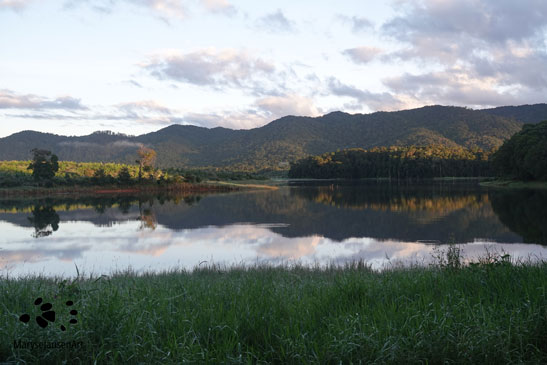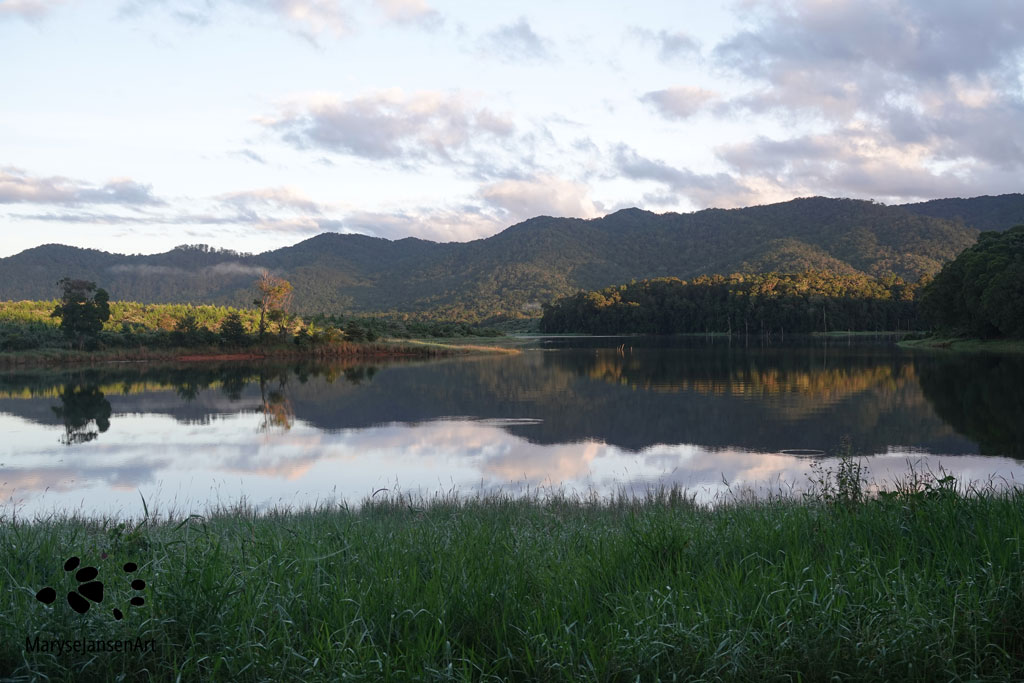Landscape Photography with marysejansenart
The best platypus viewing experience

Table of Contents
My favourite alarm clock
I woke up just before the crack of dawn to my favourite alarm clock: the Laughing Kookaburra! I got up for a little stroll and this place hadn’t lost it’s magic overnight. I was camping at Lake Tinaroo in Danbulla National Park in tropical north Queensland.
The scenery in front of me was just as beautiful at sunrise as it had been at sunset. The colours were entirely different now: the intense yellows, oranges and reds from last night had made place for a palette of soft pink, lilac and blue pastels. It was so still. The only thing that broke the silence was the screeching of the cockatoos but in a way that only added to the magic of the moment!
Images of Giant Rats now long forgotten (read my earlier post The Secrets of the Night at Lake Tinaroo), I detected that the stillness of the water was silently interrupted by circle-shaped ripples. That could only mean one thing: platypus!!!
Egg-laying mammals
Platypus are fascinating animals! They are a very unusual type of mammal, called a monotreme. It means they lay eggs! Yes, a mammal that lays eggs – and after their young come out of the eggs they suckle them. The only other animal in the world that is also a monotreme is the echidna, which is native to Australia as well.
The platypus looks a bit like an otter with a beaver-tail, a leathery duck-bill and webbed feet. They are excellent swimmers and spend much of their time in the water, hunting for food. They come on land to rest and sleep in their well hidden burrows, which can be found on the river banks just above the water level.
Electrolocation
When diving for food they close their eyes, ears and nose and rely entirely on electrolocation to find their prey. Their electroreceptors are located in the skin of their bill and are extremely sensitive in picking up electric fields generated by muscle contractions. This ingenious system allows them to hunt for shrimps and yabbies (crayfish) in murky waters. They store their catches in their cheek-pouches while diving and eat them when they come back floating on the surface of the water.
Venomous spurs
Platypus have spurs on their ankles. On females these are only rudimentary but the males have spurs that carry venom. The venom contains proteins that are produced by the platypus’ immune system to battle viruses and bacteria. Through the spurs it can also be used as a defense against other animals. It causes excruciating pain and oedema but is not life-threatening to humans. The production of the venom goes up during mating-season which indicates it is used as a sign of dominance over other males.
Platypus viewing tips
- Platypus are native to eastern Australia and can be found along the eastern rivers, lakes and ponds from Tasmania up to the base of Cape York
- They prefer habitat with steep, vegetated river banks in which they can dig their burrows
- They are solitary animals. If the habitat is really good for them you may see more animals in near proximity of each other
- They are most active around dusk and dawn
- They spend a lot of time under water, only surfacing for about 10-20 seconds between dives
- Some places have build a platypus viewing platform – a bit similar to a bird hide – from where you can observe the platypus without them seeing you
- They are extremely shy and therefore difficult to observe. Make sure you are absolutely still and quiet and be patient!

Patience pays off
I have had the opportunity to see platypus in the wild on several occasions. It really does involve being quiet and patient for a long time. It is so exciting when your efforts pay off and you do get to see one! Imagine how thrilled I was to unexpectedly see not one, not two, but numerous platypus foraging in this quiet corner of Lake Tinaroo!
Enjoy this short video that I took of this moment, take in the sound of the cockatoos and try to spot the circle-shaped ripples on the surface of the water that you now know were made by these amazing creatures called platypus! You can see these ripples on the photo too!
If you’d like to read more stories about my landscape photos, click the button below and subscribe to receive the e-book ‘5 of my favourite Landscape Photographs and the Stories behind them’ for free!
If you are interested in purchasing ‘Sunrise over Lake Tinaroo’ or would like to see what it looks like on the various products, please head to my shop.


